Synapsids
- This group includes mammals and the ancestors of mammals ("proto-mammals" or "mammal-like reptiles")
- Synapsid skull with just one temporal foramen
- Have two or more types of teeth
|
Pelycosauria
- Most primitive and reptile-like of the Synapsids
- Sprawling posture with legs held to side
- Tail long
- Some (but not all) had tall dorsal sail
- Extinct by end of Permian Period (251 mya)
| 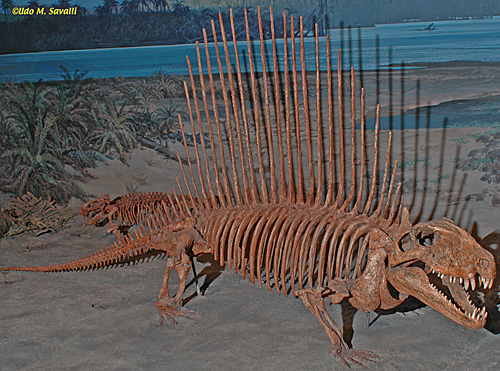
Dimetrodon fossil, Permian Period, North America (MAL1)
|
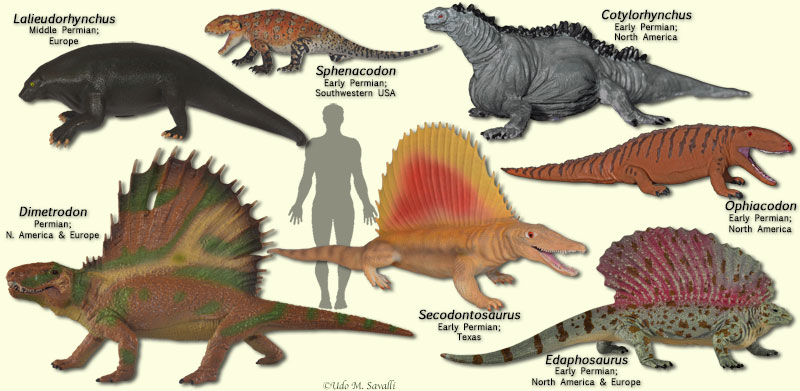
View Larger Image
Our Changing Views of Prehistoric Reptiles: Dimetrodon
See lab manual Exercise 12 for more information

View Larger Image
|
|
Therapsids
- A paraphyletic group (some are more closely related to cynodonts and mammals)
- Very diverse forms and lifestyles, inlcuding both herbivorous and carnivorous forms
- Posture somewhat sprawling (less so than Pelycosaurs)
- Varied teeth
- Relatively short tail
| 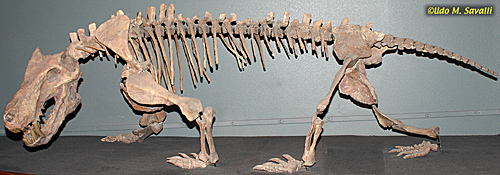
Inostrancevia skeleton, Permian Period, Russia (AZMNH)
|
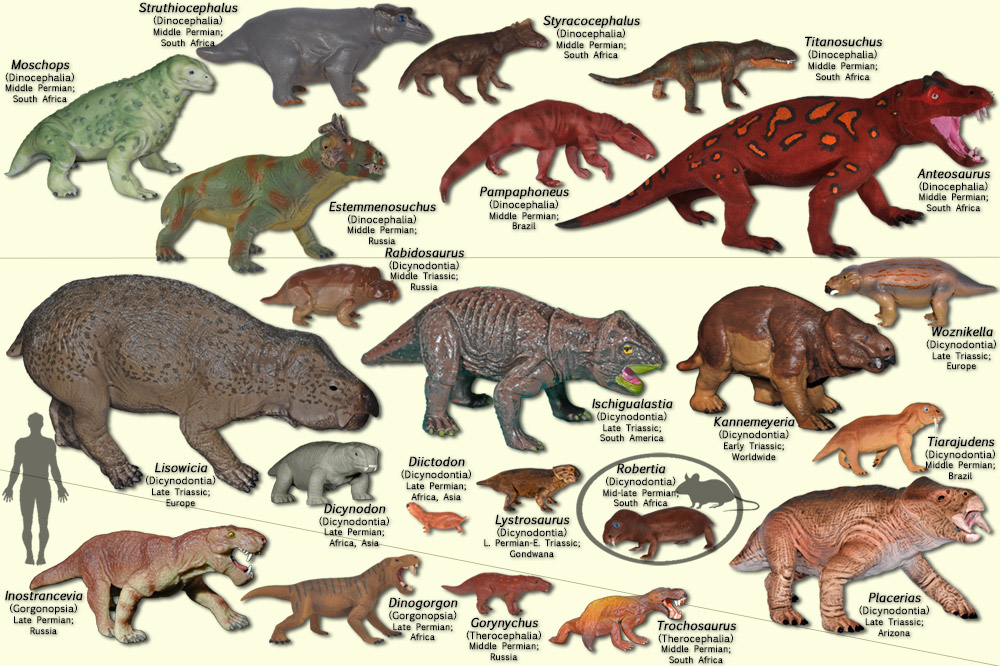
View Larger Image
|
Cynodontia
- A paraphyletic subgroup of Therapsids that are most closely related to mammals
- Mostly relatively small and carnivorous
- Complex teeth with multiple cusps (points)
- May have been endothermic and with hair?
| 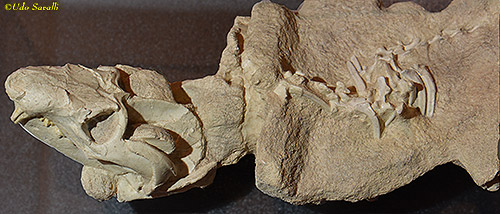
Chiniquodon kalanoro fossil, a cynodont; Middle Triassic; Madagascar (CFM)
|

View Larger Image
|
Mammalia
- Diverse, with ≈5000 species alive today
- Have hair (endothermy)
- Mammary glands provide milk for young
- Only 2 tooth generations (teeth not continuously replaced)
- Upright posture with limbs held beneath body
- During Mesozoic mammals were relatively small, inconspicuous
| 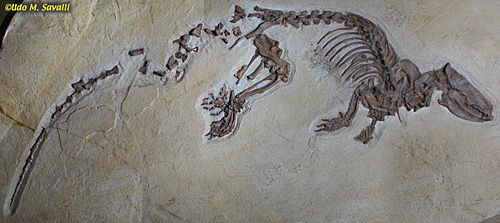
Palaeosinopa fossil, an otter-like mammal from a now-extinct group; Eocene Epoch (Green River Formation), WY (WDC)
|

View Larger Image
|
|
Stem Reptiles
- Various miscellaneous extinct groups from near the base of the reptile tree
- Some hava a generalized, ancestral lizard-like shape
- Others became more specialized
- Primarily date to the Permian Period
|
The Earliest Reptiles
- The oldest known reptiles
- Generally lizard-like (though with front and hind legs more or less equal length)
- Have an anapsid skull (lack temporal openings)
- Includes the oldest known reptile (Hylonomus) from the Carboniferous Period
| 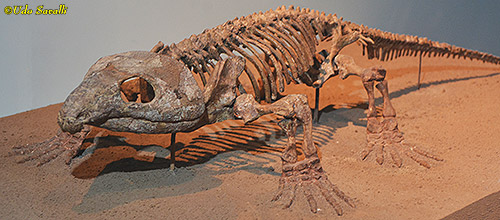
Labidosaurus hamatus skeleton, Permian Period, Texas (CFM)
|

View Larger Image
|
Parareptilia
- Have anapsid skulls that lack temporal openings
- Some are lizard-like quadrupeds (ancestral form)
- Others specialized into bipedal runners, semi-aquatic forms, and large armored herbivores
- Extinct (although turtles were once thought to belong to this group)
| 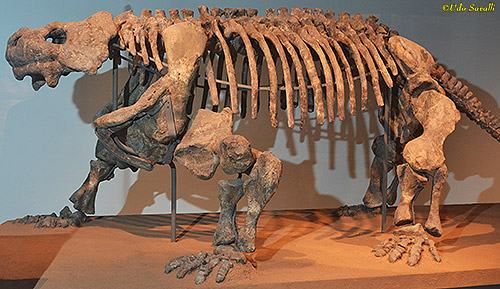
Bradysaurus baini skeleton, Permian Period, South Africa (CFM)
|
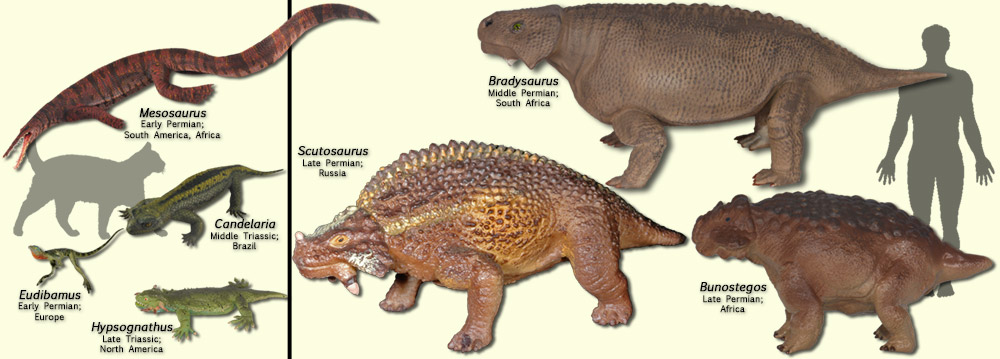
View Larger Image
|
|
Diapsida
- All have a diapsid skull (2 temporal openings behind orbit), though secondarily lost in a few (e.g. turtles)
- All extant (living) reptiles, including dinosaurs and birds, belong to this clade
- Ancestral forms generally lizard-like in body plan
- Major groups include the lepidosaurs, euryapsids (marine reptiles), and archosauromorphs
|
"Avicephala" (Triassic Oddities)
- An obscure group of primitive diapsid reptiles
- Generally lizard-like body shapes (elongated body, long tail, limbs sprawl out to sides)
- Small, bird-like heads (large eyes, pointed snout)
- Arboreal: mostly lived in trees
- Many species had unusual adaptations, including wing-like structures for gliding, giant thumb claws, grasping tails ending in a "claw", broad, leaf-like tails, or a row of greatly elongated upright scales (?) along its back
- Known from Permian to Triassic Periods
- This group may be polyphyletic: relationships are being debated
|

View Larger Image
|
Thalattosauria (More Triassic Oddities)
- Relationships unknown besides being diapsids
- From Triassic only
- Semi-aquatic: broad, webbed feet, and long, flattened tail for swimming
- Snout distinctive, either long and pointed or with distinct down-turned tip
| 
Skeleton model of the Thalattosaur Xinpusaurus kohi, Late Triassic Period, China
|
Lepidosaurs (except mosasaurs)
- This group includes the modern lizards and snakes (squamates), the superficially lizard-like tuataras (only 1 living species) and some extinct groups
- Generally lizard-like, with elongated bodies, usually long tails, and limbs that sprawl out to the sides
- Rhynchocephalians (tuataras and extinct relatives) are superficially lizard-like, but differ in their skull and other internal features
- Modern tuataras are similar to prehistoric species
| 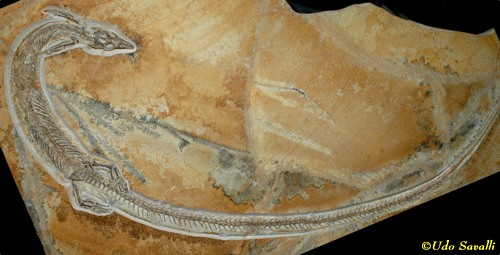
Pleurosaurus fossil, a semi-aquatic rhynchocephalian (relative of tuataras) (WDC)
|
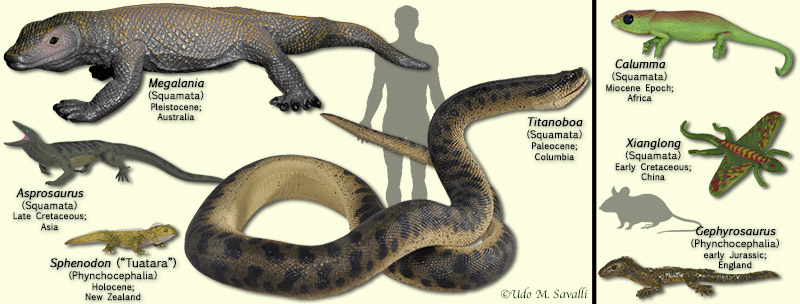
View Larger Image
|
Mosasaurs
- Part of the Lepidosaura, but very distinctive, so we will treat them separately
- Cretaceous lizards (Squamata) related to modern monitor lizards
- Most were fully aquatic and very large (the most primitive forms such as Dallasaurus were small & semi-aquatic)
- Note elongated body and tail (which distinguishes them from Pliosaurs)
- Moderate-sized flippers, with the front flippers larger than the back (compare to Thalattosuchian crocodiles)
- Recent specimens indicate at least some (and perhaps all) mosasaurs had a forked tail fin
| 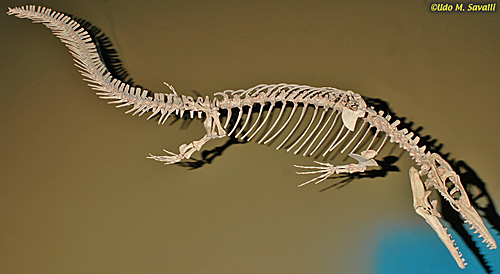
Halisaurus fossil, late Cretaceous, North America (WDC)
|
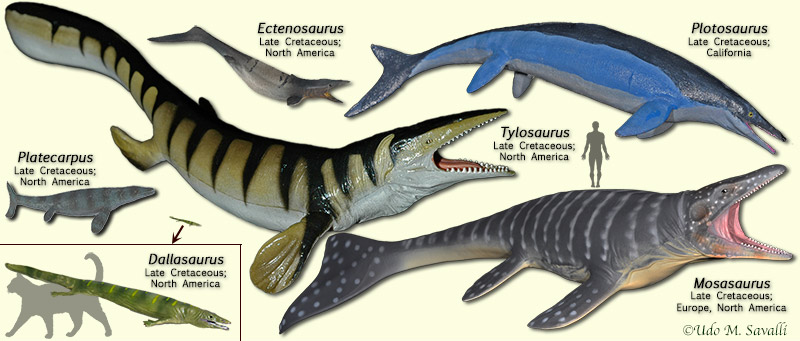
View Larger Image
|
Our Changing Views of Prehistoric Reptiles: Mosasaurus
See lab manual Exercise 12 for more information

View Larger Image
|
|
Marine Reptiles: "Euryapsida"
- All of the species grouped here have a semiaquatic (crocodile-like) or fully aquatic lifestyle
- Fully aquatic lifestyles evolved several times independently in Mesozoic reptiles
- Most have a euryapsid-type skull (single opening but in different location than synapsid skulls) that is derived from a diapsid skull
- A few recent studies suggest that the species listed here may form a monophyletic clade: more data are needed.
|
Testudines
- Turtles
- Their relationships have been long debated, but recent evidence suggests they may be related to other marine reptiles
- Distinctive shell with upper and lower half (most primitive turtle only has lower half)
- Shell derived from ribs, sternum, and dermal bone
- Skull lacks teeth in all but most primitive species
- Most are semiaquatic, but range from fully terrestrial to fully marine
| 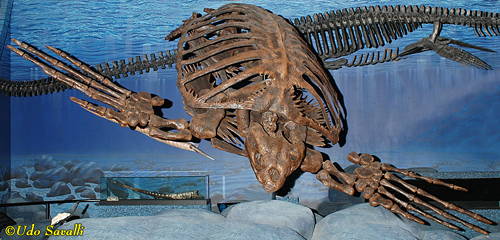
Archelon ischyros skeleton, Late Cretaceous, North America (MAL)
|
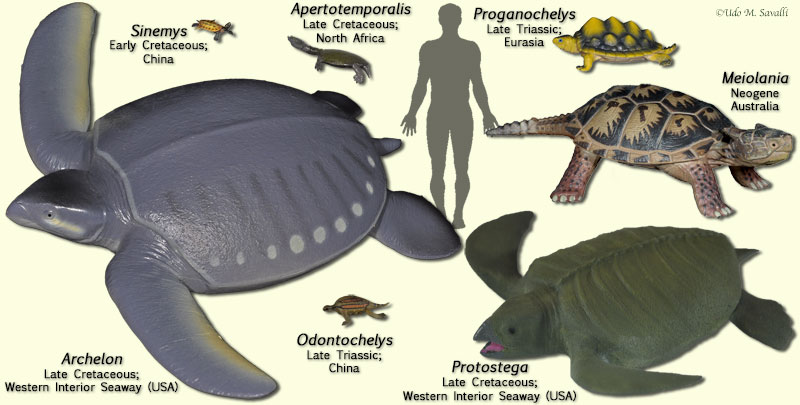
View Larger Image
|
Ichthyosauria
- The phylogenetic postion of this group has been debated and is uncertain
- Most with dolphin-like appearance, with a dorsal fin and vertical, crescent-shaped tail fluke
- Long, slender snout in most (some were toothless)
- Varied considerably in size
- Earliest ichthyosaurs had short snouts, lacked dorsal fin and lacked tail flukes (e.g. Cartorhynchus)
- Hupehsuchians were semi-aquatic ancestors of ichthyosaurs
| 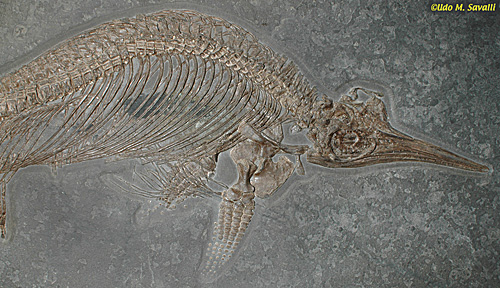
Stenopterygius fossil, Jurassic Period, Germany (WDC)
|
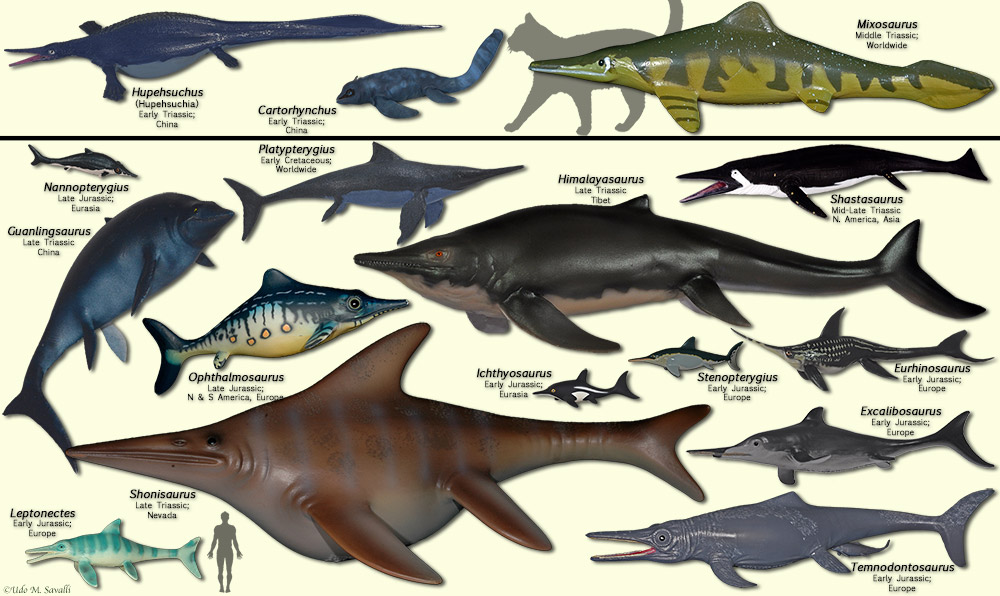
View Larger Image
|
Placodontia
- Semiaquatic reptiles living near shores
- Some were lizard-like in shape
- Many had extensive turtle-like dermal armor
- Triassic Period only
| 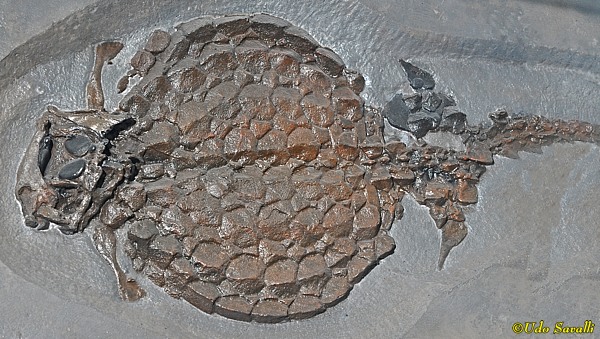
Sinocyamodus? placodont fossil cast, Triassic, China (BHI)
|

View Larger Image
|
Nothosauria & Other Sauropterygians
- Semiaquatic reptiles with elongated necks and fairly small heads
- Had webbed feet (instead of true flippers)
- Nothosaurs Intermediate between Placodonts and Plesiosaurs
- Atopodentatus is a unique species likely related to the Placodonts
- Its wierd T-shaped head was filled with tiny teeth
- It probably grazed algae
- Triassic Period only
|

Neusticosaurus edwardsi fossil, Triassic, Switzerland (BHI)
|
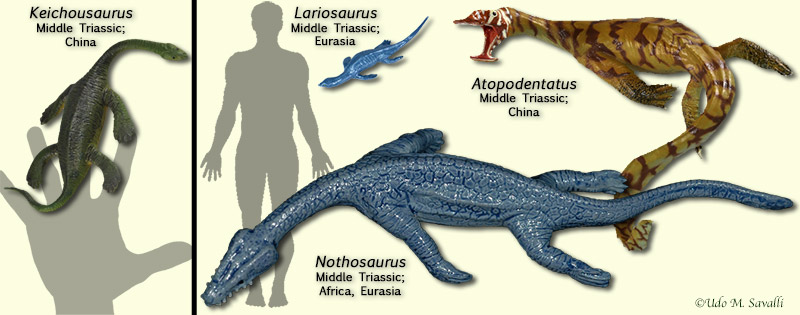
View Larger Image
|
Plesiosauria
- Fully marine reptiles
- Long flippers used for swimming
- Body relatively short, broad, and stiff, with short tail (compare to Mosasaurs)
- Short tail may end in small fin (for stability, not power); orientation of fin uncertain
- Body shapes range from long-necked and small headed to short-necked and large-headed (Pliosaurs)
| 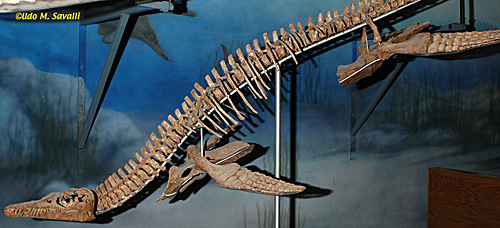
Polycotylid plesiosaur skeleton, Cretaceous Period, Morocco (WDC)
|
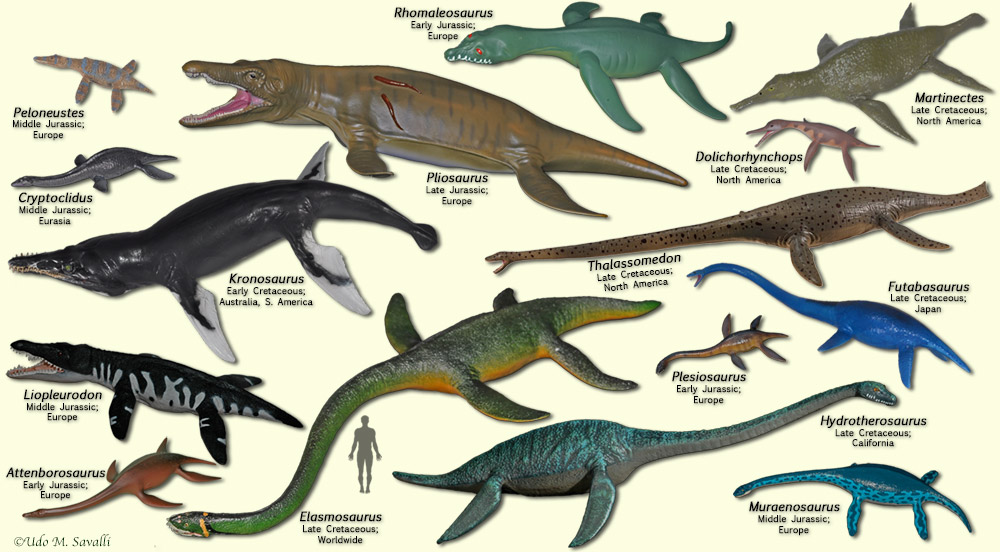
View Larger Image
|
|
Stem Archosaurs
- Here we are combining various primitive members of the Archosauromorpha into a paraphyletic group
- United by various small skeletal characteristics
- Shapes and lifestyles are quite varied
- Appeared in Permian, reached greatest diversity in the early Triassic Period (the result of a post-extinction adaptive radiation)
- Main subgroups (don't need to know) represented in lab are:
- Choristodera: Crocodile-like predators (e.g. Champsosaurus, Hyphalosaurus)
- Protorosauria: Varied, some lizard like, some long-necked and semi-aquatic (e.g. Tanystropheus), and some gliders (e.g. Sharovipteryx & Ozimek)
- Rhynchosauria: small, stocky herbivores with beak-like tooth plates (e.g. Hyperodapedon)
- Allokotosauria: An odd mix of herbivores (e.g. Shringasaurus) and possibly also gliding forms (e.g. Kuehneosaurus, Icarosaurus)
- Proterosuchidae: Odd, long-nouted reptiles (e.g. Proterosuchus)
- Erythrosuchidae: Large-headed predators that appeared shortly after the Permian extinction (e.g. Garjainia)
- Proterochampsia: Elongated, semi-aquatic, some with dermal armor (e.g. Vancleavea)
- Euparkeridae: a small, slender insect-eater with legs held beneath the body rather than sprawling; close to the ancestry of crocodiles, dinosaurs, pterosaurs (e.g. Euparkeria)
|
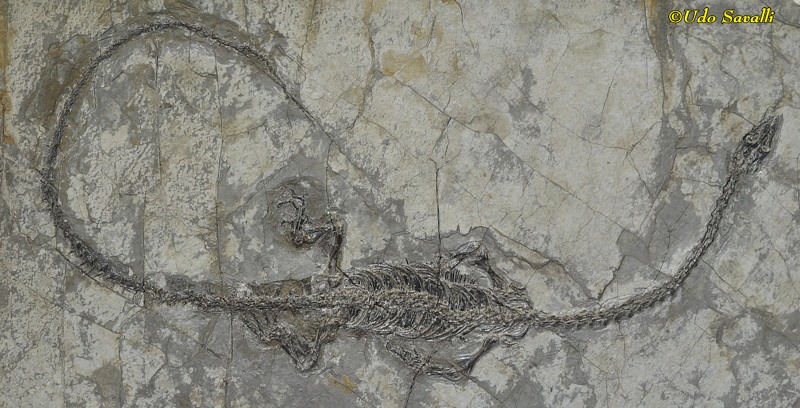
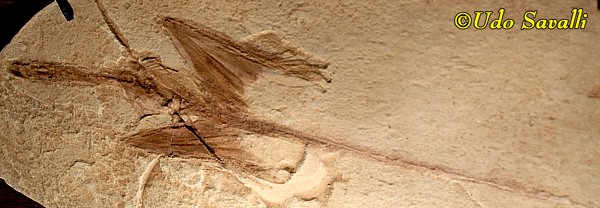
Left: Hyphalosaurus lingyuanensis fossil (Choristodera), early Cretaceous, China (BHI); Right: Sharovipteryx mirabilis (Protorosauria) fossil cast, middle Triassic Period, Kyrgyzstan (AZMNH)
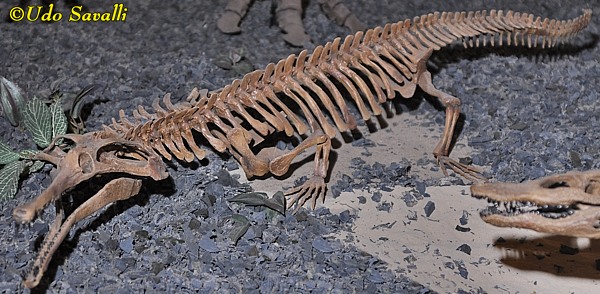 Left:
Left: 
Left: Champsosaurus laramiensis skeleton (Choristodera), late Cretaceous, SD (DRC); Right: Icarosaurus siefkeri fossil cast (Allokotosauria?), late Triassic Period, NJ
|
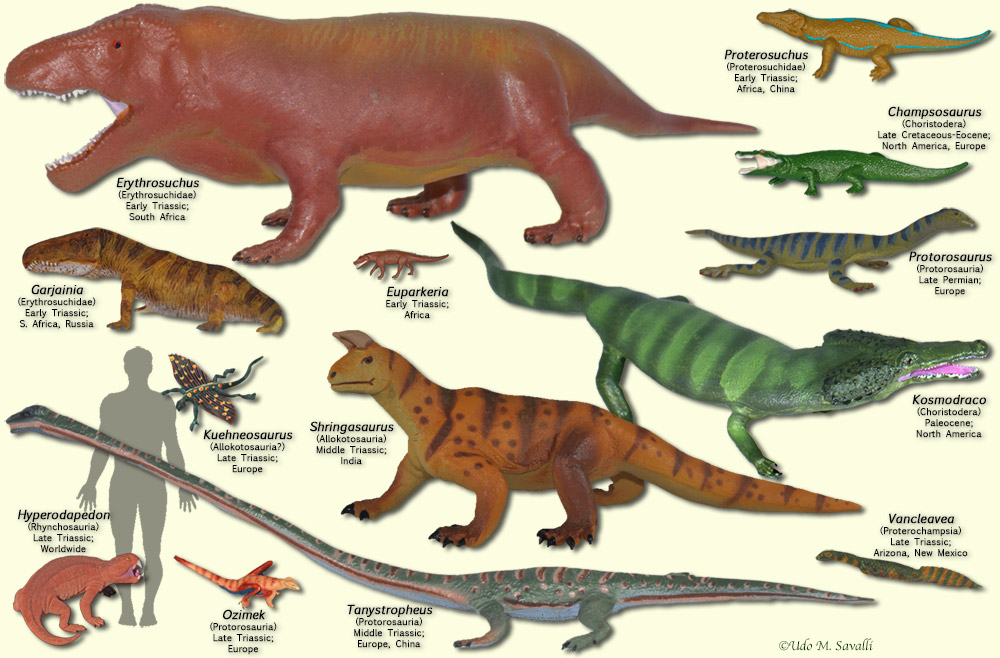
View Larger Image
|
|
Pseudosuchia
- Like other archosaurs, have teeth set in sockets and antorbital and mandibular fenestrae
- Distinguished by more flexible ankle joint
- Surviving members include the crocodiles and alligators
- Most (except crocodylomorphs) went extinct at end of Triassic Period
|
Phytosauria
- Large, sprawling, semi-aquatic carnivores
- Long, slender snout, with nostrils close to eyes
- Convergently resemble modern crocodiles (and especially gavials)
| 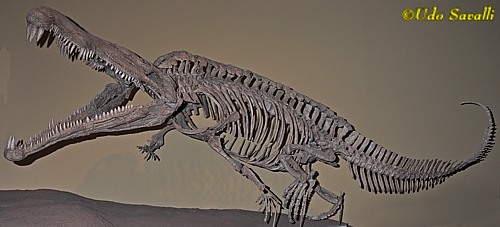
Redondosaurus skeleton, Triassic Period, North America (NMMNH)
|
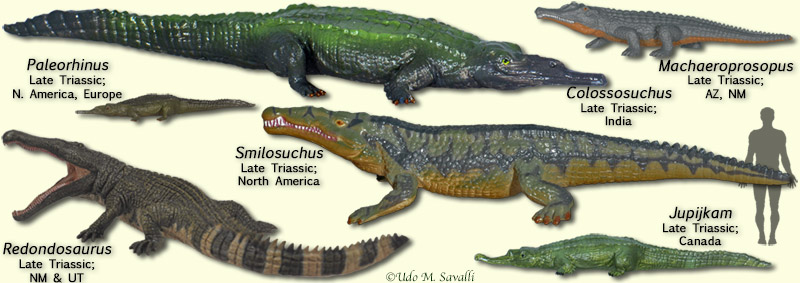
View Larger Image
|
Aetosauria
- Heavily armored with bony plates covering back, spikes on sides
- Relatively small head
- Herbivorous (convergent with Ankylosaur dinosaurs)
| 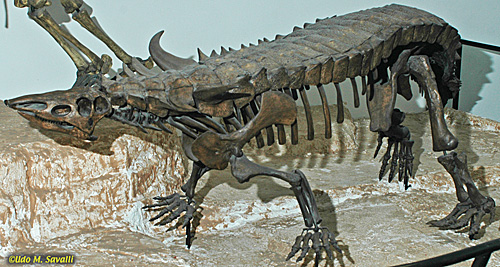
Desmatosuchus Skeleton, Triassic Period, Chinle Formation, Arizona (PFNP)
|

View Larger Image
|
Poposauroidea
- A monophyletic group of crocodile ancestors, generally related to the Rauisuchians
- Mostly moderately sized, with long necks and lacking osteoderms
- Diverse builds and lifestyles
- Some were toothless
- Some had sails
- Some were bipedal (convergent on theropod dinosaurs); others were quadrupeds
| 
View Larger Image
|
"Rauisuchians"
- The dominant large, terrestrial predators during the Triassic
- Large heads
- Crocodile-like armor scutes on back
- Legs held beneath body; hind legs longer than front (some bipedal?)
- Recent studies suggest that this group is paraphyletic
| 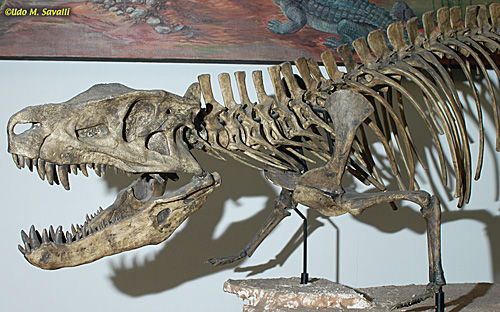
Postosuchus Skeleton, Triassic Period, Chinle Formation, Arizona (PFNP)
|

View Larger Image
|
Notosuchia
- A group of stem crocs from the southern hemisphere
- Back covered in armored scutes
- Terrestrial, with legs held beneath body
- Diverse in appearance and lifestyle: includes herbivores, omnivores, carnivores
- Some were burrowers with armadillo-like bands of armor
| 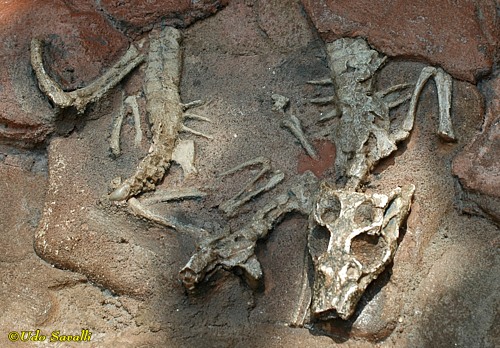
Araripesuchus fossil, late Cretaceous Period, South America & Africa (FMNH)
|

View Larger Image
|
Neosuchia
- Includes modern alligators and crocodiles and extinct relatives
- Includes the modern Crocodylia
- Generally had elongated snouts
- Back covered in armored scutes
- Mostly semiaquatic (including all moderns species): elongated body, flattened tail, and sprawling limbs
- Paraphyletic: the fully aquatic Thalattosuchians are derived from within this group (see below)
| 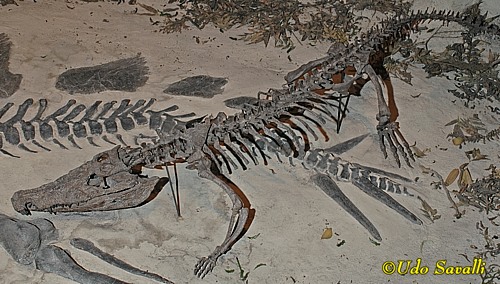
Goniopholis skeleton, late Jurassic Period, North America & Eurasia (MAL)
|
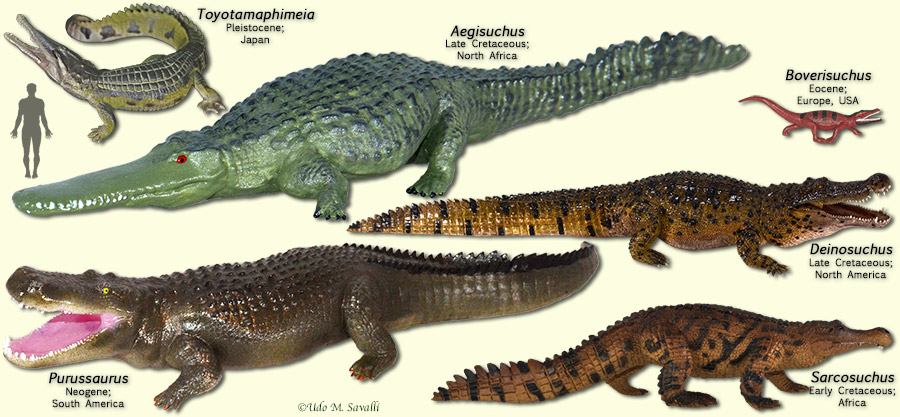
View Larger Image
|
Thalattosuchia
- A clade of fully aquatic crocodylomorphs (crocodile relatives)
- Adapted to marine environment: limbs form paddle-like fins
- Hindfins larger than small front fins; toe structure usually visible
- Tail fluke present
- Lacked dermal armor of other Pseudosuchians
| 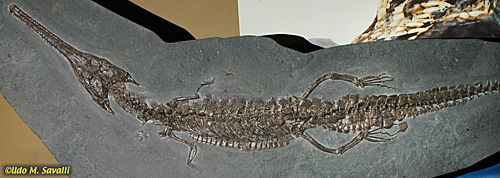
Macrospondylus (formerly Steneosaurus) fossil, early Jurassic Period, Europe (WDC)
|

View Larger Image
|
|
Footnotes
- Abbreviations for museums where photos were taken
AZMNH = Arizona Museum of Natural History, Mesa
BHI = Black Hills Institute of Geological Research, SD
CFM = Field Museum, Chicago, IL
DRC = Dinosaur Resource Center, Woodland Park, CO
FMNH = Fernbank Museum of Natural History, GA
MAL = Museum of Ancient Life, Lehi, UT
NMMNH = New Mexico Museum of Natural History
PFNP = Petrified Forest National Park, AZ
SGDDS = St. George Dinosaur Discovery Site, UT
WDC = Wyoming Dinosaur Center, Thermopolis
|
|
































 Left:
Left: 













